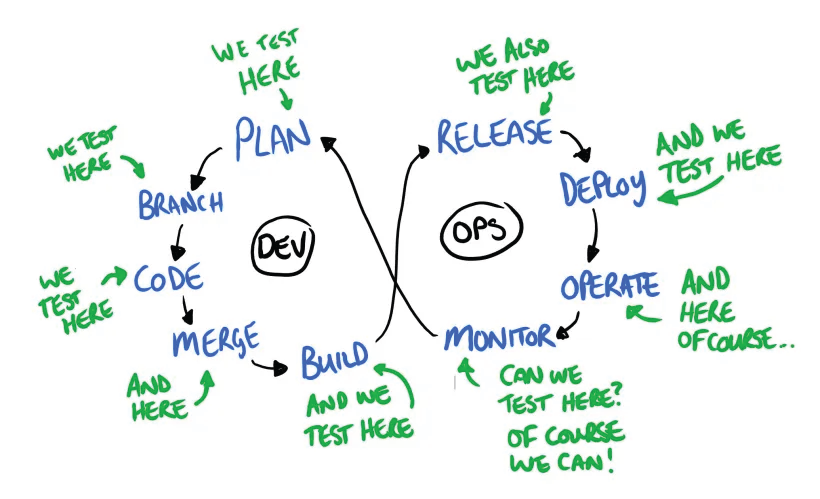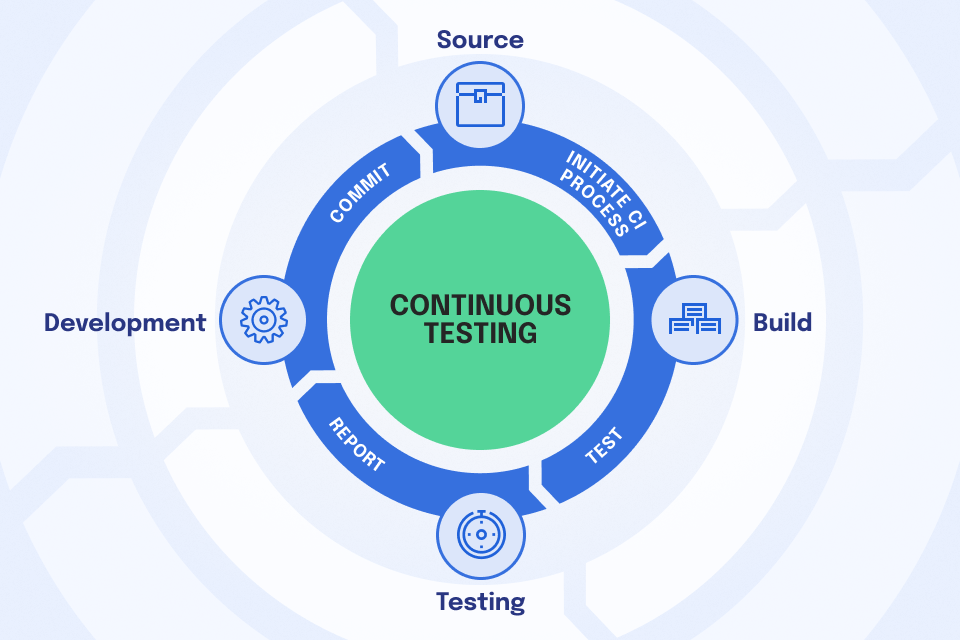What is the goal of Continuous testing?
To evaluate the quality of the software being produced across the entirety of the software development life cycle, with the aim of providing critical feedback and enabling higher-quality and faster delivery time.
The goal of Continuous Testing (CT) aligns perfectly with the individual and combined goals of Continuous Integration, Continuous Delivery and Continuous Deployment models: which is to deliver valuable and functional software to the end-user at a high frequency.
At 2i, we test at every point in the software testing lifecycle.

Figure 1 - Dan Ashby's Continuous Testing in DevOps Model
What better way to ensure the product goes out the door as intended than through using CT on top of these methods.
The need to excel in providing digital solutions and experiences in any software and product release is critical. Because of this, development and testing cycles are being squeezed. That’s where CT comes in, mitigating the risks that can come from this sped-up and error prone process. Continuous testing accelerates release cycles, while providing early and continuous feedback to stakeholders, improving the overall test coverage, reducing the cost of defects financially and from a time-to-delivery perspective, and… music to any company or projects ears, it’s easy to implement!
Automated testing and deployment aids in better response to changes in the market. Updates are developed quicker and released frequently. Developed code that’s existing or new, is rigorously and constantly tested and verified. Rapid error solution is at the forefront of CT’s targets, ensuring clean code delivery, allowing for integrations and accelerated launch of applications on a consistent basis, with speed. Deployment of CT into the SDLC ensures early, actionable feedback to the development team about any issues that the code may cause to existing functionality. The benefit of having frequent feedback at every development stage helps to expedite the release of software applications into production environments with a lesser number of defects. On top of this, business risk coverage can be analysed, helping in achieving a faster time to market.
With proper implementation of CT, testers, developers, business analysts, stakeholders and all involved in projects are assured that all critical errors in the application are identified very early on in the life cycle, and before integration commences. When code undergoes change, errors are expected to occur, as all reading have more than likely experienced. Well, CT ensures a faster turnaround time when dealing with identifying and eliminating these errors early in the development life cycle. Thus, reducing the overall cost of resolving defects, this is a huge benefit of implementing CT into your SDLC!

Figure 2 - Continuous Testing Lifecycle
CT processes can be easily integrated with existing CI/CD pipelines, without requiring new/additional tools. Where an organisation does not already have an existing CI/CD pipeline implementation, they should consider the commencing of one immediately with CT firmly in mind, to reap the many benefits it provides.
In conclusion:
In 2022, in the USA alone, the cost of poor-quality software grew to $2.4 trillion! That’s 7.7 trillion apples…pardon the pun. The point is, Continuous Testing is proven to enable cost-effective and rapid releases by detecting the early issues in the development life cycle, optimising development, and reducing overall costs. Software delivery becomes more agile with improved quality and faster product release. So, have a think about your SDLC and the benefits that will come with Continuous Testing, so that your project or company doesn’t contribute to the above figure!
Continue the conversation with us on LinkedIn and Twitter
